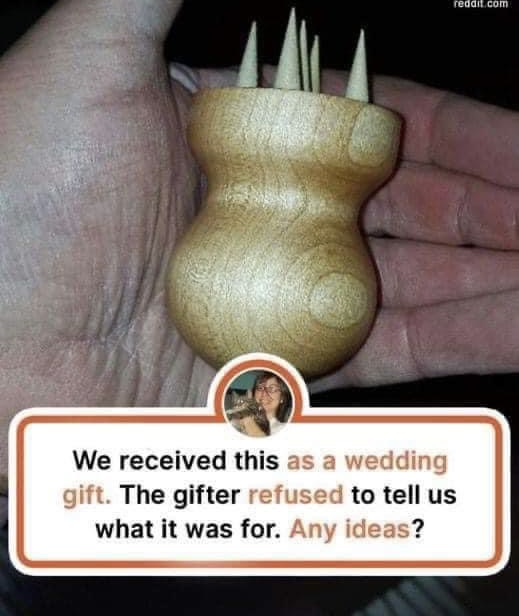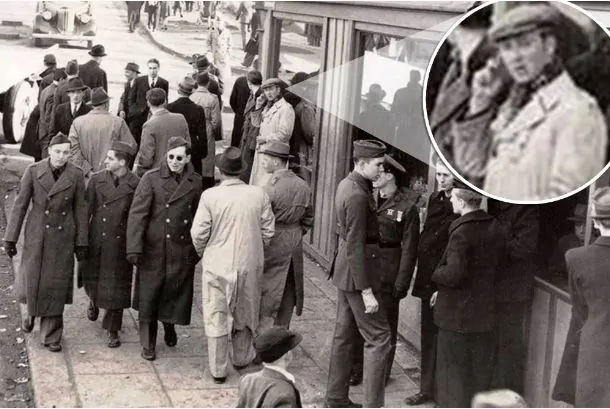Items That Had the Internet Anxiously Searching for Clues
The best available detective right now may be found online. Furthermore, there are so many enigmatic objects around that we unquestionably require detective abilities, such as the internet.
Only the collective intelligence and knowledge of the millions of online users could decipher some of the posts on the subreddit “What is This Thing?” (WITT).
20 of the most enigmatic objects we could find are listed below:
1. Looks like Clay
Question: My 3-year-old came home from an extracurricular activity where he can exchange tickets at a “store” for what’s usually dollar store items. It’s rubber/ silicone, the size of a fingertip, doesn’t erase, about as hard as a bouncy ball but doesn’t bounce like a bouncy ball. Doesn’t light up. What is it?
Answer: It looks like an ’80s light bulb eraser without the metal bottom editing to add they never really erased anything.
2. Curious Bell
Question: An iron cone on either side of a gate outside the entry to a building in Bath England.
Answer: It’s a snuffer. A visitor to your house would use it to put out their torch.
3. Golden Pig
Question: What is this thing? Small gold pig container with a removable tiny spoon for a tail.
Answer: Salt cellar. Also, known as a Salt Pig. It is a utensil to have salt easily accessible by your side while working in the kitchen before the age of shakers.
4. Road Safety
Question: What are these blue reflecting markers for? They are mounted on a pole, facing the field.
Answer: They are reflecting the headlights of cars to the fields so that deer avoid crossing the road. So it’s for the safety of cars and animals.
5. Old Car Accessory
Question: Found on the dashboard of an old GMC. A lucite-like material, with ridges.
Answer: It’s a traffic light viewer. Traffic lights back in the day were mounted on the same side you stopped on which sometimes made it difficult to see the light if you were first in line, this helped reflect the light from above so you could tell when the light changed.
6. Ingenious Road Sign
Question: A variable stop sign in Illinois?
Answer: These are blinders, typically used so the sign can be read from a narrow-angle. They’re also called directional shields. You’ll see them at traffic lights a lot more often.
7. An Ancient Household Object
Question: Found it when cleaning my parents’ basement. Looks like some sort of bookholder or something. It is made out of wood and the paint is heavily chipped. Ripped-up pieces of newspaper were found inside the top compartment, one of which was dated 1967.
Answer: Italian (Florentine style) phone stand. Forgot to say, yes, there should be a drawer, for pens and paper and a personal phone book. The vertical cavity is for your city phone book or books. The top is a handle for moving it about.
8. Fancy Bath
Question: This fancy hotel has a shallow tub with two sides. When the button is pressed, one side lights up with a red light and hot water for about 30 seconds. Then the other side lights up with blue light and cold water and shuts off after the same amount of time.
Answer: This is very common in Germany, we call it “Wechselbad.” You’re supposed to keep your feet in the warm water first and then quickly put them in the cold water (repeat a few times). This is supposed to help with circulation, although I’m not sure if there’s actually scientific evidence for that. We usually have these in spas and other wellness or health-related facilities.
9. Metal Pumpkin
Question: A pumpkin thing that opens on a hinge, latch inside with a small glass jar. A sharp pin is attached to the jar. There’s a flat glass surface that opens to reveal a little compartment.
Answer: It might be a “vinaigrette,” a piece of jewelry containing smelling salts or perfume that women hung from a chatelaine chain in Victorian times.
10. Strange Spoon
Question: Found this while cleaning out the attic. It’s wood, looks handmade, and measures 20cm, but I have no idea what it is or does!
Answer: Perhaps it’s a Yacouba Double Spoon – a symbol of hospitality in traditional African art. It represents two very distinct universes that are opposite.
11. Straight Crop Circles?
Question: Random-ish straight but not parallel lines next to my office building… What’s happening here?
Answer: You probably live in the UK, where planning authorities often require developers to do “evaluation trial trenching” to make sure there are no important archaeological artifacts that might be destroyed by excavation.
If the trial trenches turn up anything interesting, a more serious archaeological dig may be required before building can begin. As far as I’m aware, this practice is unique to the UK. We definitely don’t do it in the US, and I haven’t heard of it being done in Europe.
12. Weird Design
Question: What is this growth on my mugs after I microwave them?
Answer: Ceramicist here. So clay bodies are porous, depending on the material. Porcelain is dense, and earthware and stoneware are less. Either way, liquids can move through fired clay. A glaze that goes on the outside can look solid but can have hundreds of tiny cracks and holes. When you microwave liquids or just let them sit in a ceramic vessel they can seep through and crystallize in the cracks and holes.
This usually only happens with handmade or cheap ceramics. Sometimes this is done on purpose and is referred to as a “crackle” glaze. When it happens on accident it’s called crazing, when the tensile strength of the glaze doesn’t match the clay body during firing.
13. Cool Compass?
Question: Found at a used book store. All parts rotate and the markings/months make me think it could be for mapping.
Answer: An astrolabe, the ancient times GPS. Used usually for navigation, also for time measurement, and other scientific uses. I got one similar to a keyring. If it’s too small It won’t be easy to use, in my experience.
14. Fancy Scissors
Question: A Scissors-like device I bought years ago at a flea market.
Answer: It’s a vintage umbilical clamp. That’s why it’s shaped like a stork! Eventually, this style evolved into several types of embroidery scissors that the midwives would use while awaiting labor.
15. Not A Pet Door
Question: What is this hatch I’ve seen on the outside of houses in the UK?
Answer: It’s a boot scraper, for getting the mud off your shoes before going in. They are pretty common.
16. Writing Utensils
Question: A small metal object, fits in the palm of my hand. The gold-colored part slides up and down but can be locked in place with the adjuster screw. Found at a flea market, the vendor has no idea what it is and has had several people try to figure it out. May or may not be just a part of something.
Answer: Looks like this fountain pen holder for an embosser.
17. It’s Not What You Think It Is
Question: Scoopy Doodad was found in a junk drawer.
Answer: The classic Sunbeam Mixmaster had a juicer attachment, a bowl that attached to the top of the mixer. This is the spout the juice would pour out of. The wire part held a little strainer to filter out the pulp.
18. Built-in Cigar Holders?
Question: Sliding tray with holes on both sides of this sofa.
Answer: Tray table. It has another piece to it. It’s a tray with matching pegs. The tray goes on top and the pegs slide in. They fit together so the tray sits tightly. Then you take the tray back to the kitchen and put the sliding part back so it’s not in the way.
19. Styrofoam Secrets
Question: What are these sets of seven dimples on styrofoam?
Answer: While many plastic objects have little marks on them where the liquid plastic is injected into the mold, expanded polystyrene objects (“Styrofoam”) aren’t made this way. Instead, small granules of plastic are pre-treated with steam in a large hopper, which causes them to expand into little foam pellets.
These foam pellets are poured into the mold, and then additional steam is injected in, causing the pellets to swell even more until they completely fill the mold. The little seven-dot marks are steam injection points. You can tell the difference between expanded and extruded polystyrene because you can see the individual pellets in an expanded foam object, it has a “grainy” appearance when broken, while extruded foams are just a solid block.
20. DIY Insect Repellant
Question: Seen while walking down the street. A ziplock bag tacked above a door. Seems to contain water and a few pennies. What could this be for?
Answer: Homemade mosquito/fly deterrent. The light reflecting off the water and pennies is supposed to scare off pesky bugs.

























